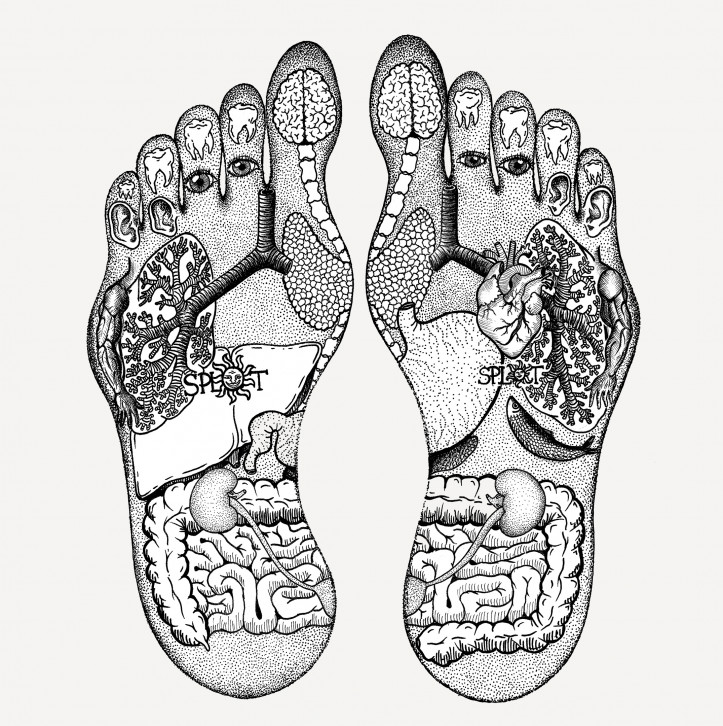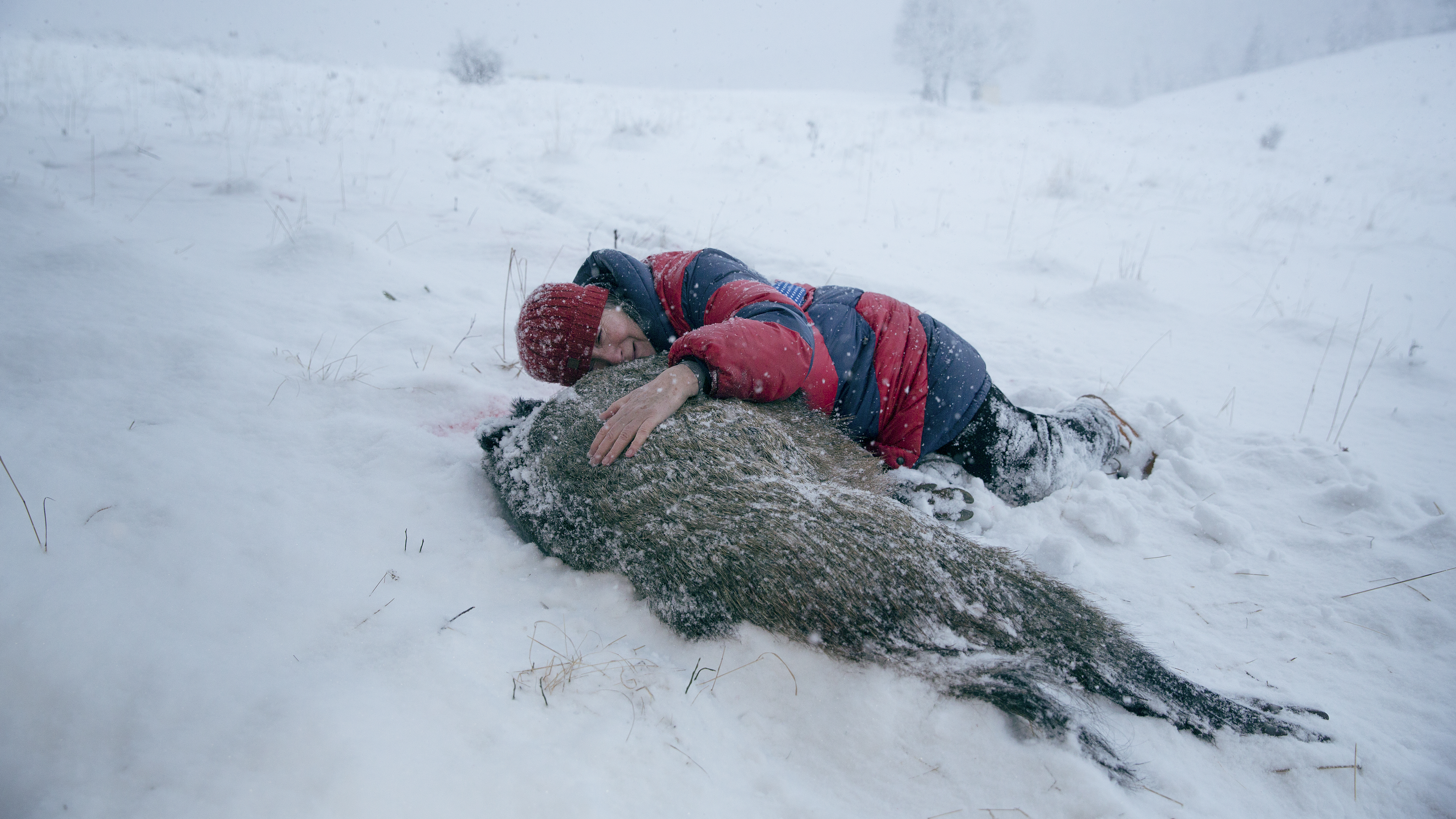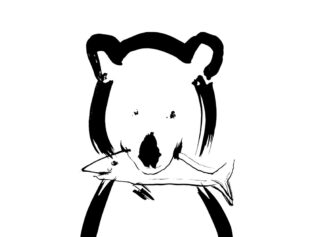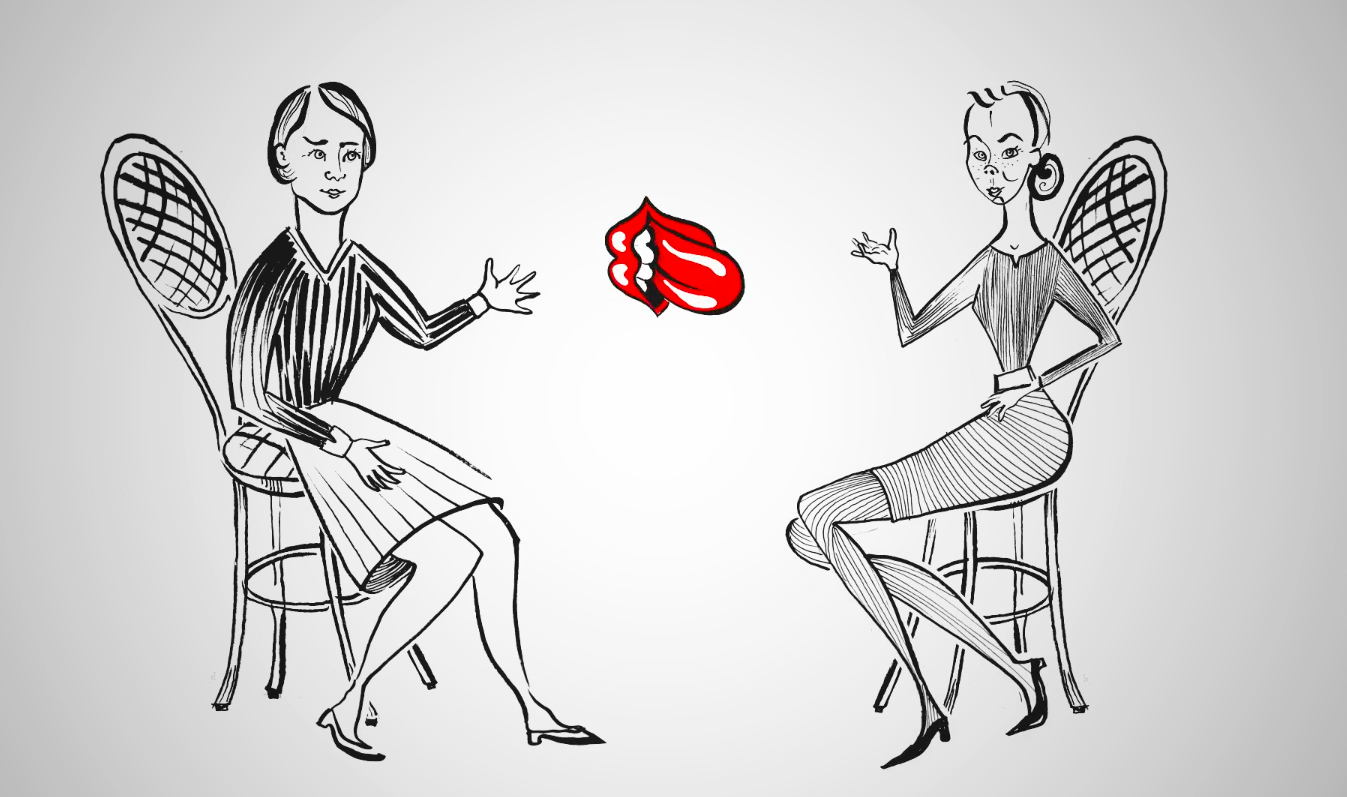
Walking barefoot puts your thoughts in order, unclogs your head and can be a synonym of freedom. But it’s also part of a cultural code that helps us break routines or enter the realm of sanctified behaviour.
How can we manoeuvre in this labyrinth of meanings? Look below your feet and in front of you. On this path, we’ll be accompanied by Professor Arnold Lebeuf, a cultural anthropologist who for years headed up the Sociology of Religion Department at the Jagiellonian University’s Institute for the Scientific Study of Religion. When I ask about the sources of going barefoot, he refers me to his book Stopa bosa, stopa obuta. Semantyka motywu ikonograficznego [Barefoot, Shodden: The Semantics of Iconographic Motifs], and it will be our roadmap.
In every family, a child’s first steps are a celebrated event. Very often they’re memorialized in a souvenir – a cast of the tiny feet. Shops offer kits for this occasion: a magical can with child-safe plaster, a frame with a forming substance. You just have to press down and close up your most precious memory in a box. Why do we place such weight on footprints?
Our footprints have been speaking about us and helping us understand, for as long as we’ve been around. You can read them like a book. Some theories about the beginnings of writing refer to animal tracks. According to a Chinese legend, which Lebeuf takes from the Sinologist and researcher on ancient China Marcel Grant, writing was invented by a minister in the court of the mythical emperor Huang Di, observing the tracks left on the ground by birds. He arranged these marks into letters. “For hunters, reading tracks must have preceded language in general, meaning writing.” He continues: “Footprints create an archaic language.” Their importance is shown by the specific cult that has grown up around them. As the professor notes: “All over the world, and from prehistoric times, honour has been paid to footprint-shaped depressions in rocks and stones.” It was believed that the water that gathered in them had particular power, so people used it to wash their eyes.
In Sri Lanka, the faithful make pilgrimages to Adam’s Peak, to the footprint which is interpreted, depending on your religion, as coming from Buddha, Shiva, Adam or St. Thomas. In many Buddhist holy places, there are more marks seen as holy – famous ones include the Bodh Gaya shrine in India and Thailand’s Wat Phra Phutthabat. Jesus supposedly left his right footprint on the Mount of Olives a moment before his ascension. According to one pilgrim’s account, he poured wine into the depression so that others, kissing the relic, would dip their lips into it. There’s no shortage of similar examples in Poland: Mary’s footprint in a stone in Licheń, or those in places of supposed appearances in Białka, Zajączki, Zawady in Podlasie, on Bardzka Mountain in Lower Silesia.
The print of a bare foot is like a signature. Whether it’s from our ancestors or the gods, it’s a seal of presence. You can put an equals sign between ‘left a footprint’ and ‘was here’ or ‘is here’. And though it might seem that the word ‘barefoot’ is a synonym of poverty, it turns out that among the many meanings of and reasons for going without shoes, the one related to economic factors is the weakest. For example, in the Talmud walking barefoot denotes mourning.
Where and when?
Shoes should be taken off when crossing the threshold of a house in Asia and in other places, too. This custom has been adopted in many Central and Eastern European countries, as well as Scandinavia, as Lebeuf points out. The home is a sacred space, a sanctuary. In Eastern cultures, entering in shoes means taking possession, and so it’s just a small step to seeing this behaviour as undignified, even an act of aggression.
Being barefoot also plays a role where the private meets the holy – during celebrations of rites that are important from the faith perspective. In the Middle Ages, people observed Christmas Eve by eating standing up, with a single spoon and a common bowl. The tradition of sitting down to the Christmas Eve table became widespread in the 19th century. Household members were to be barefoot as a sign of humility, abasement before the mystery of the Incarnation.
Janina Ipohorska – who for years taught Poles savoir-vivre in the pages of “Przekrój” under the nom de plume Jan Kamyczek and published books including Grzeczność na co dzień [Everyday Courtesy] – had a different opinion. You’ll look in vain for an injunction from her to take off your shoes after crossing the threshold of somebody’s home. On the contrary, such a practice is in poor taste, because how can you imagine guests in their Sunday best with bare feet, or worse, in their host’s slippers?
In the shrine with humility
In many countries, it’s required to enter shrines barefoot. In Thailand and China, you can’t step on a threshold with bare feet, so as not to allow evil spirits in (contrary to appearances, this isn’t always easy, because it may turn out that you’re faced with a large beam, which is difficult to get across.). Why is this important? There can be many reasons. When touching the floor of a shrine, we’re close to the object of worship. The gesture of removing your shoes in itself repeats the custom of washing the feet of the priests before entering the holy place. At the boundary of sacrum and profanum, we discard that which has had contact with the dirt of the street, which may be impure. In ancient Egypt, servants stood barefoot before the face of their masters.
Humility is one of the important trails of meaning. In 2019, German President Frank-Walter Steinmeier, during the observances of the 80th anniversary of the outbreak of World War II, said: “I […] stand barefoot today before the people of Poland, as a human being, as a German, weighed down by a huge historical burden.” Bare feet are a sign of abasement, an attribute of pilgrimage. On the trail in Medjugorje, many older people, who have difficulty moving even over a flat surface, climb steep slopes barefoot. The route to the place of the apparition is a path over sharp, protruding stones, which often wound feet that aren’t used to this kind of contact. Pain sanctifies, though when observing such people from outside, it’s just as easy to doubt the sense of such suffering.
On the boundary
Insofar as bare feet in public spaces may astonish, even greater astonishment can be caused by the sight of a person with just one shoe. But this motif is exceptionally common in iconography. It has meandered through various cultures and geographical regions. These are the trails that Lebeuf follows particularly closely in his book. What points do they mark on the map? “In ancient times it was sculpted, painted in frescoes, laid out in mosaics. In the Middle Ages, the Renaissance and up to the threshold of Modernity it appears in sculpture, painted panels, on canvas, woodcuts, etchings.”
The most interesting things always happen on the periphery, the places where two worlds connect, and those are indicated by presenting one foot bare and the other shod. Monosandalism, the term that describes this motif, “appears particularly often in examples closely connected with boundaries, borderlands of what we call reason, organized society, the place where real life and the established order break down.” It’s an attribute of demigods, heroes or initiates, and this connection with initiation rites is particularly resonant.

Initiations themselves happened on the boundaries of inhabited areas and nature; boundaries of the ordered, subjugated world and the wild one, where ghosts, beings residing in between this world and the next, have the right to coexist. If we created a gallery of such figures, we couldn’t leave out participants in the Eleusinian mysteries; Dionysus in his Bacchic robes; Medea, whose deeds transcend the order of nature; the one-shoed figures populating the micro-cosmos of Breughel’s paintings; and the Prodigal Son from Rembrandt’s canvas, who kneels before his father wearing one shoe as a sign that he’s returning to the established order. This motif is also present in fairy-tales. Animals operate on the border of what’s known and what’s untamed. In the symbolism of representations, the spirits and souls of beings not from this world were often incarnated in them. The figure of the one-shoed animal returned during the time of Carnival, when in a special way, through the gaps of existence, in an upside-down order of things, the influences of chaos could slip through.
Wearing a single shoe is also an attribute of death. Those who are travelling to the other world or arriving from it, and cross the boundary to the other side, usually have one bare foot. In the Aeneid, Dido ascends the funeral pyre in a single shoe. The crucified Wilgefortis, a bearded female saint whose cult was never sanctioned by the Church, at the moment of her martyrdom has a slipper on just one foot (this is the presentation we find in the shrine in Wambierzyce, in the Kłodzko region).
The powers of the underworld that manifest their presence in iconography in this way can also be much more dangerous. Monosandalism often marks devils and demonic figures. In Agnieszka Holland’s film Spoor, Janina Duszejko and Matoga find the body of their neighbour, Big Foot. His shrivelled body lies on the floor. When they pick it up and lay it on the bed, you can clearly see that one foot is bare, and the other wears a heavy shoe. This frame speaks louder than words, and perfectly conveys what Duszejko is thinking in the novel, though in Olga Tokarczuk’s book Drive Your Plow Over the Bones of the Dead, which the script was based on, this scene looks slightly different. Janina notices her neighbour’s foot when she takes off its dirty footwraps.
“I have always regarded the feet as the most intimate and personal part of our bodies, and not the genitals, not the heart, or even the brain, organs of no great significance that are too highly valued,” Tokarczuk writes. “It is in the feet that all knowledge of Mankind lies hidden; the body sends them a weighty sense of who we really are and how we relate to the earth. It’s in the touch of the earth, at its point of contact with the body that the whole mystery is located – the fact that we’re built of elements of matter, while also being alien to it, separated from it. The feet – those are our plugs into the socket. And now those naked feet gave me proof that his origin was different. He couldn’t have been human. He must have been some sort of nameless form, one of the kind that — as Blake tells us — melts metals into infinity, changes order into chaos. Perhaps he was a sort of devil. Devilish creatures are always recognized by their feet — they stamp the earth with a different seal.”
Big Foot is a poacher and a person who’s bad right down to the ground (you want to say: to the earth, to the place his feet touch!). The nickname itself, which Duszejko gives him, is by no means a coincidence, because asymmetrical limbs or having one foot larger than the other – as in the case of Oedipus or Shakespeare’s Richard III – indicates imperfection, being cursed with evil, which after a certain time reveals its destructive power. The description can be replaced with a brief picture. The question is whether we know how to decode it. For some, it’s a scene that fits with the film’s poetics, for others an element of a semantic code – demonism, a connection with death, with crossing the boundary of the worlds. In Islam, until today going about in a single sandal is seen as a sign of Satan.
Walking as experience
The degree to which what we walk on affects our perceptions can be felt when visiting the permanent exhibition in Oskar Schindler’s Enamel Factory in Kraków. The floors (there’s more than one) change. We start to look at what’s under our feet.
“The first element that constitutes any space is the agreed-upon ‘floor’,” says Łukasz Czuj, a director and creator of narrative exhibitions, who designed this space together with scenographer Michał Urban. “In Schindler’s Factory we could have removed all walls and ceilings and just left the floors, and we’d still maintain the rhythm of the narration. You’re always standing on some kind of floor: it describes the space, it’s the most directly experienced. We pass by the walls, the ceiling flickers away up there somewhere, but the floor, even if we don’t see it, we feel.”
A street paved with swastika-pattern tiles, creaking hardwood, linoleum, quarried stone. What’s under your feet means and hurts. Sometimes literally, because when we walk on the soft rubber surface we lose our self-confidence despite ourselves; we feel growing unease. The creators of the exhibition treated the story of the time of the occupation as a spectacle. To build the narration and the dramaturgy, they used the rhythm of steps, knocking on pavement. And while it wasn’t designed for barefoot walking, even so we clearly feel the thick network of meanings beneath the soles of our shoes. Monika Bednarek, who runs this division of the Museum of Kraków, assures us: “We haven’t had anybody visit the exhibition this way, barefoot, but if they wanted to, I don’t see any reason not to.”
The idea that touching the space beneath your feet is a unique experience, and going barefoot may even be a way of life, is advocated by the members of the Association of the Barefoot Warmian Peasants, who created a special barefoot labyrinth in Praslity next to Dobre Miasto. The 250 metres of unique sensory paths were designed to provide a variety of stimuli: stones, evergreen needles, bark, raw wood. If we add to this morning dew, rain or snow, the sensory possibilities are infinitely greater. The walls of the labyrinth are planted with climbing plants, to confuse the paths of those who want to wander in it.
Closer to the earth
Going barefoot also grounds us in the energetic sense, as jazz pianist Leszek Możdżer – for whom walking onstage barefoot is part of his costume – has discussed. Bare feet make your whole body resonate. You can capture the trembling of the boards, hear more fully, because the perception of sound isn’t limited to what we take in by hearing.
Bare feet in public space may be a tool of emancipation. In 2016, photos of a barefoot Julia Roberts on the red carpet in Cannes rocketed around the world – she was protesting the restrictive rules requiring the wearing of high heels during the festival. A year earlier, several women were refused entry to a screening of a film about opposition to the patriarchal vision of the world only because their heels were too low. More such situations occurred. Even health concerns were no argument for the organizers. You can discuss violence against women; the system that sets things up so that for many of them it’s a source of suffering, but it’s best to do it with women in red dresses with cleavage, on a 10-20-centimetre heel, without reflecting that the traditional dress code replicates these same oppressive schemes. Note that the Cannes film festival also forces male photographers to wear elegant suits that hamper their work.
In the theatre, an unwritten rule prohibits actors from entering the stage in their own shoes. Contemporary dance theatre, so strongly rooted in the body and its impulses, usually takes place barefoot, which for many artists of the global music scene is an integral part of their image. This is a consequence of the creative path and a life attitude. Barefoot ecology has a connection with nature and the energy of the earth. If you go to a Florence and the Machine concert, you are who you want to be; a boy with a wreath on his head, with gold glitter in your hair and on your eyelids, because an hours-long barefoot show is a story about the importance of a community that doesn’t exclude anyone. What counts is that you respect others and the resources at your disposal, and here bare feet bring us down to earth. Going outside the lines helps you feel free, even at the price that they call you a freak.
Allowing employees to work without shoes, with or even without socks, is an increasingly common practice in Silicon Valley start-ups. The contact we have with the floor is connected to how we live and work. It roots us, stabilizes us, frees us to greater creativity. In this case, breaking the form serves making even more money, generating profits, but not in the personal dimensions. The San Francisco Public Health Department issued an opinion stating that this practice is completely in line with occupational health and safety rules.
“Usually what’s most beneficial has the least value and meaning among people; it is not heeded, but dismissed and rebuked. This is how it is with going barefoot. Going barefoot has great significance for the human body, so if everyone learned its value and meaning, they would never ever stop going barefoot.” Thus Hildegard of Bingen, whose words are invoked by the Barefoot Peasants. If you believe their experience, going barefoot gives you something more: “Good cities, good villages, good people, good words, good thoughts.”
In response to the question of where else we enter cultural traditions barefoot, Professor Lebeuf replies: “At the pool, in bed, in heaven.” Some already do it here on Earth.
Translated from the Polish by Nathaniel Espino










